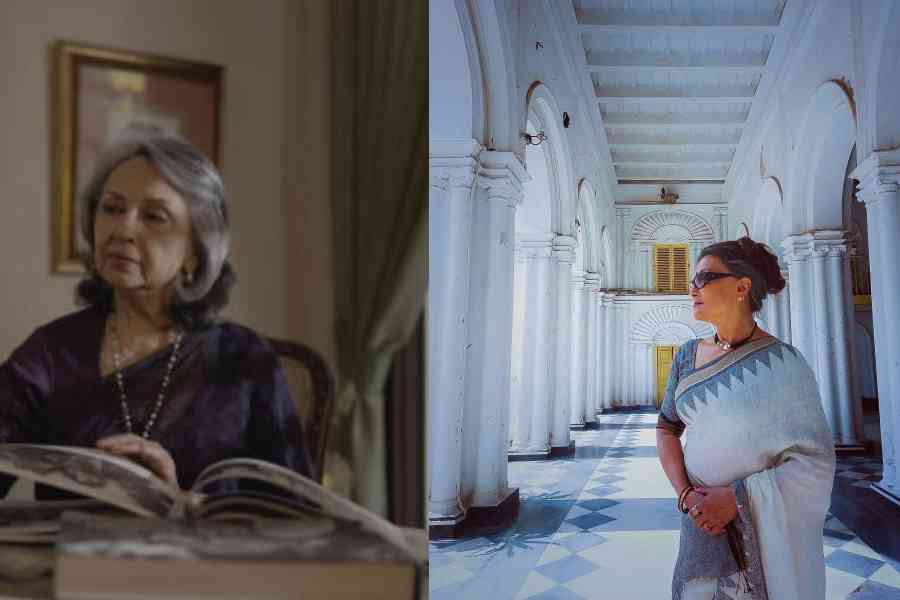Aparna Sen was recently celebrated with a retrospective held in London. Three of Sen’s best films, The Japanese Wife, 36 Chowringhee Lane and Paromitar Ekdin (House of Memories) were screened at the two-day event, staged at the Nehru Centre in Mayfair and Cine Lumiere in South Kensington. The retrospective was the initiative of Big Bazaar Films, a film company set up in 2022 by Aritra Sen and Alex Harvey, to produce and promote quality Indian cinema which speaks to a global audience.
The Bengal Heritage Foundation collaborated with Big Bazaar Films to organise the retrospective in London which was attended by not only members of the diaspora but people from the British Film and Television industry. “Aparna is a legendary figure in the Indian film industry, someone we deeply admire for her track record both as an actress in films by Satyajit Ray and Mrinal Sen as well as a very significant independent director in her own right,” said Aritra Sen.
With the help of the Bengal Heritage Foundation, the retrospective featured a newly-restored print of Sen’s debut film, 36 Chowringhee Lane (1981). “The quality and confidence of Aparna’s direction is evident right from the start in the way she sensitively captures Jennifer Kendal’s outstanding lead performance as Violet Stoneham. 36 Chowringhee Lane is 43 years old but portrays a way of life in Calcutta so effectively... it’s still fresh and, now, timeless,” adds Alex Harvey.
Big Bazaar Films also has an Aparna Sen film in development, Her Indian Summer, a mixed-race love story set against the tumultuous buildup to Partition in 1947. “We’re delighted to be working with Aparna on an original story, which will be an English language film just like her first. This is our second collaboration with Aparna. She is an important figure in Forest of Humans, our forthcoming feature documentary about Satyajit Ray and Calcutta,” revealed Aritra Sen.
For Harvey and Sen, Ray’s legacy is still very much alive. “We have not only produced a full feature documentary on Ray’s umbilical relationship with his city but also the very first movie we’ve made together, Prantik (The Talisman), which will be released theatrically in India this autumn, is partly inspired by elements in such classic Ray films as Pratidwandi (The Adversary) and Jana Aranya (The Middleman). A t2 chat with Aritra.
Why did you decide to make Forest of Humans?
Alex and I have been profoundly moved and influenced as filmmakers by Ray’s lasting cinematic legacy. It was the reason we both wanted to work together as co-creators. We have been discussing the power and insights of his films from the first day of our collaboration. Exploring the extraordinary diversity of Calcutta together on our numerous film scouts we thought the city would be an ideal lens to examine Ray’s cinema. In the West, Ray is often viewed as a chronicler of rural India due to the impact of his debut film and masterpiece Pather Panchali. But he was rooted in Calcutta and his city films — Mahanagar, Pratidwnadi, Semmabodhho, Jana Aranya — are also extremely powerful, and, despite being a reflection of his own period, also have a timeless quality about them. We wanted to explore the discourse Ray conducts with his city, constantly finding fresh aspects through his evolving relationship with Calcutta.
What was the process like?
Ray was a prolific filmmaker. So we decided to concentrate on films which show contrasting versions of Calcutta; its historic past as in his adaptations from Tagore such as Charulata, its mid-century modernity and his 1970s Calcutta trilogy as well as his sense of Calcutta as a universal city, exploring existential questions.
Who were the actors involved?
We tried to focus on interviews with as many direct collaborators of Ray as possible. Alokananda Roy, Aparna Sen, Sharmila Tagore, Dhritiman Chatterjee, Barun Chanda, Madhabi Mukherjee. We also filmed with directors like Gautam Ghose who were deeply connected to Ray either assisting him or taking inspiration from his work. We talked as well with writers such as Amit Chaudhuri and academics like Supriya Chaudhuri who gave deep insights into Ray’s creative processes and aesthetic complexity
What did they talk about?
We filmed nearly every interview in Calcutta, choosing iconic locations in the city which were associated with Ray, either influenced him or were used as actual locations in his film. All the contributors explore how Ray himself was formed by Calcutta and how much he gave the city a mirror through which it could examine and recognise itself. They highlight how Ray could be unsparing in his clear-sighted understanding of human moral failings yet also deeply empathetic in his fellow feelings.
Aparna Sen was shot in the iconic Jorashanko Thakurbari. She is the main anchor of the film because she speaks as a filmmaker who has been inspired by Ray immensely in her own journey. Also, she started her career with Samapti. She speaks on Bengali renaissance and Tagore’s influence on Ray. Her interview was a great addition to the film as she knew Ray also as a friend of her father’s. She knows a lot of personal anecdotes which makes the interview very endearing to viewers.
We took Dhritiman Chatterjee and Barun Chanda to the places where they shot their films with Ray before. Dhritiman was filmed in the iconic Chung Wah restaurant where the famous Pratidwandi scene was filmed. We also took him up to the top of Tata Centre to look down on Chowringhee. The memories kept flooding back and he took us down memory lane with Ray. Barun Chanda was filmed in the iconic Calcutta Swimming Club to match his Seemaboddho scene. He also rides in a yellow taxi around Howrah Bridge to reminisce his days of filming the opening scene of Semmaboddho where he is driving Sharmila Tagore in an Ambassador.
How did the collaboration between you and Alex Harvey begin?
Alex Harvey had come in 2017 to Calcutta for recce. A common producer friend Avishek Ghosh introduced us and I was taking him around Calcutta and neighbouring areas to see locations for his feature film. We hit it off immediately on a mutual admiration for Satyajit Ray and his cinema. It was good to know that a British filmmaker is so passionate about Ray and his diverse range of work. Since then there has been no looking back. We worked on Prantik our first feature film together. Next, we filmed the documentary on Ray — Forest of Humans and we have several films in the pipeline which we look to co-produce and co-create together.
What are your plans with the Forest of Humans documentary?
The documentary Forest of Humans is in post-production. We are looking to clear all the archive material that we have used. Presently it is being shown to several networks worldwide and also a few esteemed festival programmers. We plan to release it in a major film festival in 2025 followed by limited theatrical in India, the UK, Europe and some parts of America. The ultimate goal is to stream it on a leading OTT platform so that people can see it worldwide and the work is also archived well.











